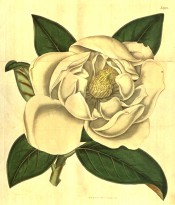Magnolia grandiflora L.
Frost hardy, broadly conical, evergreen tree with elliptic, glossy, leathery leaves, often reddish-hairy beneath, to 20cm long, and large, cup-shaped, creamy white flowers, to 25cm across, in late summer and autumn. To 18m. [RHSE, Hortus, Hilliers’].
Horticultural & Botanical History
‘The [Magnolia grandiflora] lanceolata of Hortus Kewensis, is generally known among the Nurserymen by the name of the Exmouth Magnolia, so called from a fine one mentioned by Miller, as growing in the garden of Sir John Colliton; which we suppose was the original stock from whence most of our trees of this kind have been produced. It has the advantage of flowering much more freely than [most other varieties] and of being more hardy.’ [BM t.1952/1817].
‘Their usual height [in North America] is one hundred feet, and some greatly exceed that; the trunk perfectly erect, rising like a column, and supporting a head like an obtuse cone, the dark green foliage silvered over with milk white flowers, which perfume the whole atmosphere, and so large as to be distinctly visible at the distance of a mile or more.’ [LBC no.814/1824]. Introduced to Britain in 1734. [PD]. ABR pl.518/1808.
‘It does not appear who first brought Magnolia foetida to the attention of European botanists. The earliest account, that of Plukenet, was published in his Amaltheum Botanicum in 1705. It is not known who first introduced living plants into Europe; a single specimen, said to have been brought from the banks of the Mississippi, was planted near Nantes in 1732; and two years later, according to Aiton, it was cultivated in Sir John Colleton’s garden at Exmouth in Devonshire. Magnolia foetida is the most splendid ornamental tree of the North American forests. It is now widely cultivated in the extreme southern states, and has become a striking and beautiful feature in the gardens and streets of many southern cities. It is precariously hardy as far north as Philadelphia. It has been generally introduced into the gardens of temperate Europe and Asia, although in Great Britain often requiring the protection of a wall to insure its blooming.
Several varieties have appeared at different times in European nursery-gardens, especially in those of central and western France, where the propagation of the evergreen Magnolia has been an important industry since its first introduction. These varieties differ principally in the form of the leaf and in the duration of the flowering period. The variety Exoniensis, raised in England early in this century, with a rather fastigiate habit of growth, oblong elliptical leaves densely clothed with tomentum on the lower surface, and somewhat contracted flowers, is considered in that country the most distinct, and, from its habit of flowering when only a few feet high, the most valuable for cultivation. The variety angustifolia, which appeared at Angers about 1825, is one of the most distinct and permanent of these seminal varieties. The variety praecox, another French variety, is distinguished by early and continuous blooming.’ [Sargent – The Silva of North America vol.1, p.4 /1891].
History at Camden Park
Listed in all published catalogues [T.660/1843]. Magnolia grandiflora is not grown in the gardens of Camden Park but two very large specimens survive at the site of the Old Orchard, once part of the estate and now part of Elizabeth Macarthur Agricultural Institute.
Notes
Magnolia grandiflora ex DC. (1824) = Talauma mexicana G.Don
Published Mar 24, 2010 - 11:20 AM | Last updated Mar 24, 2010 - 11:31 AM
| Family | Magnoliaceae |
|---|---|
| Category | |
| Region of origin | USA |
| Synonyms |
|
| Common Name | Bull bay, Southern magnolia |
| Name in the Camden Park Record |
Magnolia grandiflora |
| Confidence level | high |
